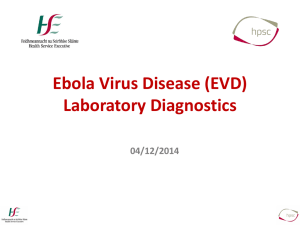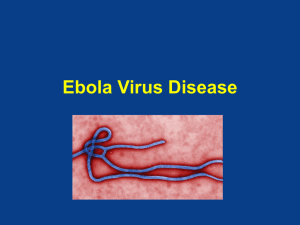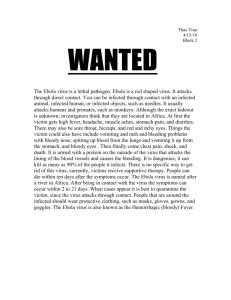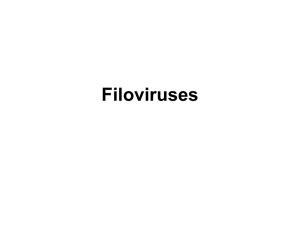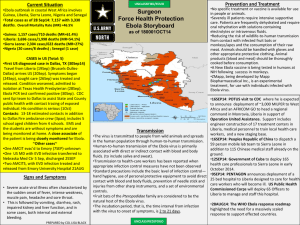Ebola FAQ
advertisement
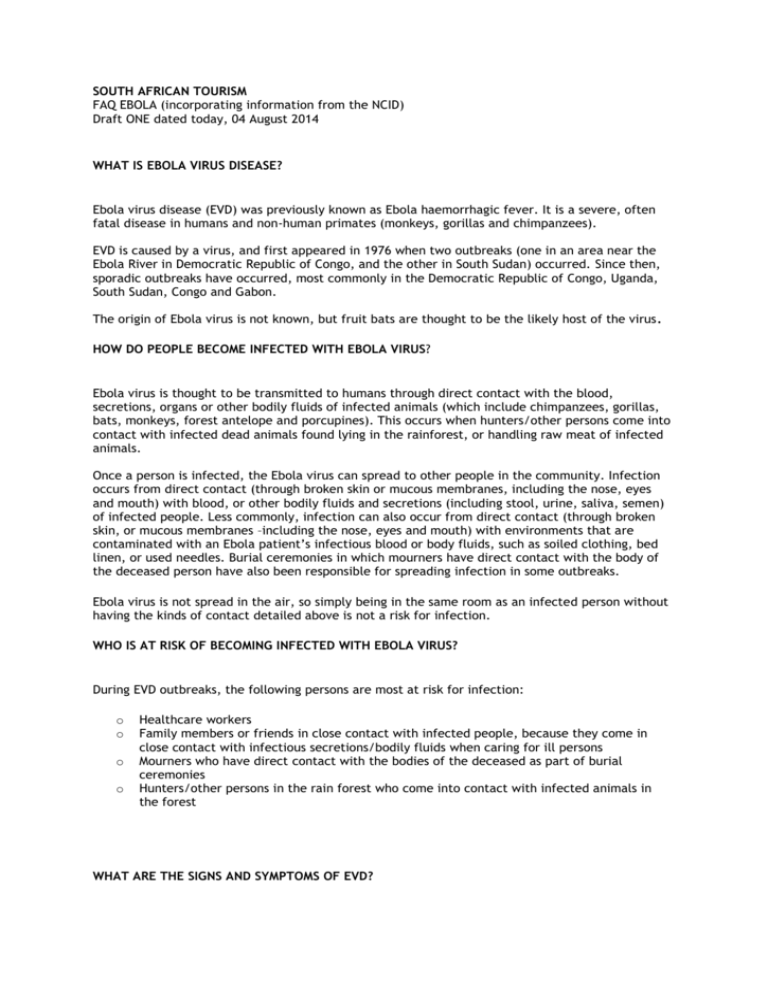
SOUTH AFRICAN TOURISM FAQ EBOLA (incorporating information from the NCID) Draft ONE dated today, 04 August 2014 WHAT IS EBOLA VIRUS DISEASE? Ebola virus disease (EVD) was previously known as Ebola haemorrhagic fever. It is a severe, often fatal disease in humans and non-human primates (monkeys, gorillas and chimpanzees). EVD is caused by a virus, and first appeared in 1976 when two outbreaks (one in an area near the Ebola River in Democratic Republic of Congo, and the other in South Sudan) occurred. Since then, sporadic outbreaks have occurred, most commonly in the Democratic Republic of Congo, Uganda, South Sudan, Congo and Gabon. The origin of Ebola virus is not known, but fruit bats are thought to be the likely host of the virus. HOW DO PEOPLE BECOME INFECTED WITH EBOLA VIRUS? Ebola virus is thought to be transmitted to humans through direct contact with the blood, secretions, organs or other bodily fluids of infected animals (which include chimpanzees, gorillas, bats, monkeys, forest antelope and porcupines). This occurs when hunters/other persons come into contact with infected dead animals found lying in the rainforest, or handling raw meat of infected animals. Once a person is infected, the Ebola virus can spread to other people in the community. Infection occurs from direct contact (through broken skin or mucous membranes, including the nose, eyes and mouth) with blood, or other bodily fluids and secretions (including stool, urine, saliva, semen) of infected people. Less commonly, infection can also occur from direct contact (through broken skin, or mucous membranes –including the nose, eyes and mouth) with environments that are contaminated with an Ebola patient’s infectious blood or body fluids, such as soiled clothing, bed linen, or used needles. Burial ceremonies in which mourners have direct contact with the body of the deceased person have also been responsible for spreading infection in some outbreaks. Ebola virus is not spread in the air, so simply being in the same room as an infected person without having the kinds of contact detailed above is not a risk for infection. WHO IS AT RISK OF BECOMING INFECTED WITH EBOLA VIRUS? During EVD outbreaks, the following persons are most at risk for infection: o o o o Healthcare workers Family members or friends in close contact with infected people, because they come in close contact with infectious secretions/bodily fluids when caring for ill persons Mourners who have direct contact with the bodies of the deceased as part of burial ceremonies Hunters/other persons in the rain forest who come into contact with infected animals in the forest WHAT ARE THE SIGNS AND SYMPTOMS OF EVD? After infection with the Ebola virus, there is an incubation period of 2 – 21 days (on average, 8 – 10 days) after which the person will start to experience symptoms. During the incubation period, the person is well and shows no signs of being infected. After the incubation period, the initial symptoms include fever, weakness and lethargy, muscle pain, headache and sometimes sore throat. This is followed by vomiting, diarrhoea, abdominal pain, and sometimes a rash. Some patients may experience bleeding inside and outside of the body; this is the most serious complication. HOW IS EVD DIAGNOSED? EVD can only be confirmed through laboratory testing, usually a blood test. A specialised laboratory at the National Institute for Communicable Diseases in Johannesburg is able to test for Ebola virus disease. EVD can only be diagnosed once a person develops signs and symptoms of the disease; there is no test available to detect infection whilst a person is still in the incubation period of disease. WHAT IS THE TREATMENT OF EVD? There is no medication available to treat the Ebola virus itself. Standard treatment for EVD is limited to supportive therapy, and severely ill patients require intensive supportive care. This consists of balancing the patient’s fluids and electrolytes, maintaining their oxygen status and blood pressure, and treating them early for any complicating infections. Some patients will recover with the appropriate medical care. In previous EVD outbreaks, 50 – 90% of Ebola patients have died. In the current EVD outbreak in West Africa, about 60% of Ebola patients have died. To control further spread of Ebola virus, patients that are suspected to have EVD should be isolated from other patients and treated by healthcare workers using very strict precautions to prevent being infected. Experimental treatment has been tested in animal models, but has not yet been used in humans. CAN EVD BE PREVENTED? There is no licensed vaccine for EVD. Several vaccines are being tested, but none are available for clinical use as yet. Preventing initial cases is challenging, since it is still not known how exactly Ebola virus is maintained in nature and what preventive interventions would be successful. Once an initial case of EVD occurs in a community, preventing spread to other people is critical. This includes educating the general public about the disease and how it can be prevented. IS IT SAFE TO TRAVEL DURING AN OUTBREAK OF EVD? The World Health Organization regularly reviews the public health situation and recommends any travel or trade restrictions. At present, no travel or trade restrictions are recommended. The risk of infection for travellers is very low, even if the visit included travel to the local areas from which primary cases have been reported. Infection with Ebola virus requires direct contact with blood, secretions, organs or other body fluids of infected living or dead persons or animals, all of which are unlikely exposures for the average traveller. There is no risk of Ebola virus transmission during the incubation period and only low risk of transmission in the early phase of disease. Historically, several cases of haemorrhagic fever (Ebola, Marburg, Lassa, Crimean-Congo haemorrhagic fever) disease were diagnosed after long-distance travel but none developed the symptoms during the international travel and no persons who came into contact with the patients during travel were infected. (Source: National Institute of Communicable Disease) HOW FAR AWAY IS SOUTH AFRICA FROM THE COUNTRIES WHICH HAVE REPORTED THE VIRUS? South Africa does not share a border with the countries where the virus has been detected. Further to this, none of our neighbouring countries have had any incidents reported. The incidents of infection and deaths have occurred in countries to the West of Africa – most notably Liberia, Nigeria, and Sierra Leone. ARE OUR AIRLINES AND OTHER PORTS OF ENTRY WELL EQUIPPED? Ebola is not transmitted through the air. You are not going to get Ebola if an infected person sits next to you or sneezes in the same room. Having said that, because the symptoms of Ebola are similar to other more common illnesses, the South African National Department of Health has assured us that all port health authorities – including those at borders - are on high alert and had taken all precautions to prevent the virus from entering South Africa. Airports in South Africa are equipped with body thermal monitoring devices which pick up unusually high temperatures in a person. Should a person be found to record higher than normal body temperatures, they will be placed in an isolated medical facility at the airport for further tests. Only once they have been given the all clear will they be allowed to proceed into the country. REPORTS SUGGEST THAT WHILE SOUTH AFRICA’S AIRPORTS ARE WELL EQUIPPED TO HANDLE THE OUTBREAK, NOT ENOUGH IS DONE FOR THE LAND PORTS OF ENTRY (BORDERS) In general, West African travelers do not enter South Africa via our land borders. It is a long and tedious journey, through many countries and it would take many days, even weeks to get to South Africa. Owing to the quick infection to fatality rate of this virus, people with the disease often succumb to the virus within a few days of infection. Should they pick up or have the virus, it is safe to assume they would not make it to our country. Is there a response mechanism should someone with Ebola come to the country? Alerts have been circulated to all stakeholders; outbreak response teams in all provinces have been trained and are on high alert. The National Health Laboratory services and National Institute for Communicable Diseases has intensified their surveillance at laboratories and are supporting epidemic preparedness and response activities. To add to this, South Africa’s Department of Health is continuously monitoring the situation in West Africa and has taken the necessary steps to detect and treat cases in South Africa. Having said that, should a foreign national test positive for the virus they will not be able to enter the country. It is for this reason why it is imperative for all visitors and residents to disclose if they have visited any of the countries affected prior to entering South Africa so that they can be medically screened. WHAT PRECAUTIONS SHOULD BE TAKEN IF TRAVELLING TO WEST AFRICAN COUNTRIES CURRENTLY EXPERIENCING THE EVD OUTBREAK? Travellers must have a valid yellow fever vaccination certificate when travelling to Guinea, Liberia, or Sierra Leone.Since these countries are risk areas for malaria, travellers should consult a healthcare professional regarding the appropriate malaria prophylaxis that needs to be taken. Malaria is the most likely cause of illness with fever in a person who has travelled to West Africa, so travellers must pay particular attention to malaria prevention. The symptoms of early EVD are the same as many other infections that can be acquired in West Africa, including malaria, dengue fever, Lassa fever, and typhoid fever. Travellers should take routine precautions to prevent such infections, including: malaria prophylaxis, preventing mosquito bites, regular hand washing with clean water and soap, and adhering to safe water and food practices. IS IT POSSIBLE THAT EVD COULD BE INTRODUCED INTO SOUTH AFRICA? There have been no cases of EVD in South Africa associated with this outbreak. What is being done to prevent or detect EVD cases that may be imported to South Africa? The World Health Organization has issued recommendations for public health authorities and transport sectors with regards travel and transport risk assessments during the current EVD outbreak. Routine screening of all passengers at points of entry is not recommended. South African Port Health authorities are on high alert for ill persons with EVD-compatible symptoms who have travelled from West Africa. An alert for healthcare workers is available on the NICD website (www. nicd.ac.za) and is updated regularly; this alert includes recommendations for assessing ill persons who have travelled to West Africa. END

